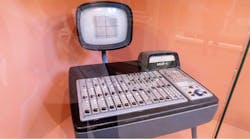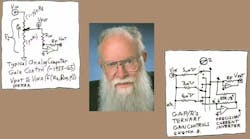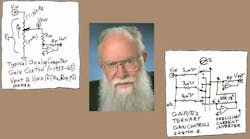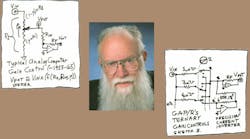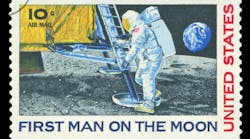Analog came first,
Computations became sound,
Music to our ears!
The legendary Bob Widlar, baby-daddy of Op Amps at National, clearly defined “any idiot” as people merely being able to count to one and forever delineated digital electronics in a vulgar meme. Though I submit that we are all somewhat sloppy about “analog’s” scope and taxonomy by failing to know/recall its entomological[sic] origins, which kinda bugs me.
Operational Amplifiers are exactly that—amplifiers that can perform mathematical operations, including summation, subtraction, multiplication, and integral and differential (calculus) functions, depending on the configuration of components and interconnects around them.
Op Amps were the heart of “Analog Computers,” where an engineer could describe a complex transfer function (simplistically, a mathematical output-to-input ratio that can vary) of a black box system as an equation, usually sprinkled with liberal amounts of calculus. Also, variables were voltages that were analogous to a real-time system’s variables, usually in mechanical or aeronautical applications, though NSA used Analog Computers for spook stuff (zoom in on the placard here), too.
In university, one of our EE lab assignments was to choose any real-world system to model, create the differential equation transfer function(s), wire up the components in an Analog Computer using patch cords (I believe our A.C. was this one) to provide both the input stimulus (usually by an integrated function generator), implement the differential equation(s), and define a way to look at the output.
I chose to do an Estes model rocket, using mass, an approximation of aero drag, gravity, and the impulse curve that happened to be included with the rocket motor. An innate masochist, I also did the equations twice, splitting the signal path, where I could input sine and cosine fixed variables by potentiometer for launch angle. Thereby I could output the downrange and altitude voltage outputs into the x and y channels of a storage ‘scope.
This patchcorded analogous circuit did work, predicting the rocket would reach ~800 ft., iirc, depicted as voltage on the storage scope, displaying the rocket’s ballistic trajectory as a gorgeous parabola drawn in persistent phosphors. By varying the angle of launch pots, I could simulate rocket launch trajectories much faster and cheaper than conducting empirical launches needing telemetry.
It’s a bit disingenuous, though, for popular media to have made the general public think that rocket science like the Apollo space program was done by nerds with slide rules. Analog computing was heavily used by us cool kids in design simulations and test rigs because digital computers simply could not process the information in real-time (to this very day with some computational problems) or compressed time (which analog computing allows by changing frequency and scaling reactances accordingly). Other ones and zeroes stuff was crunched at NASA (they were a lead customer for IBM’s computer product definition) by an IBM 360 mainframe.
The specific configuration of analog computing blocks, using patchcords, created a bespoke analog computing solution of adequate precision to model my rocket’s altitude and range as an x and y voltage output destined for a storage ‘scope based on my transfer function differential equations. Analog computing is superior, in power dissipation and throughput, to the most powerful digital supercomputer, or anything companies like Altera, Intel, NVIDIA, or Xilinx/AMD have to offer when its precision is adequate for the application.
The Sum, Difference, Product, Integral, etc. of Its Parts
An Analog Computer’s circuit blocks can include the following key components/functions as plug-in cards for the system backplane, where some those functions can appear in plurality on a card function:
- An operational amplifier1 that can sum, subtract, and integrate signals
- A four-quadrant multiplier
- An accurate voltage reference to set “machine scale” and constants
- A comparator to sense voltages and provide a true/false indication
- Integrator (RC) precision-component networks
- 10-turn precision linear potentiometers to accurately set constants/coefficients
- Switches, patches, and inverting amplifiers
- Servo-motorized precision potentiometers in some machines
If you’ve been playing along here, you’ll already have clicked the link to the Analog Computer user manual that showcases its functional blocks and how to patchcord it for various operational functions. For the YouTube generation of learners, it seems like there’s some good stuff on analog computing here. If you have a favorite learning resource or reference on analog computing, please add it to the comments.
So, there. “Analog” components are simply the building blocks of an analog computer and nothing more. To be a bit pedantic, “Analog” is not really interchangeable with “Linear” (note that Bob Pease in his very first column also put “Linear” in quotes—I went back and searched his columns after I wrote this piece) because Analog Computers often use diodes, waveform clipping techniques, and other means to produce nonlinear outputs.
Nonlinearities
A non-obvious evolution of Analog Computers was the music synthesizer. At Cornell University, Robert A. Moog clearly repurposed the Analog Computer as a musical instrument, added a keyboard, and created value for performance artists by giving them control over nonlinear, nightmarish (to us engineers), circuit behavior. Things like excessive gain, clipping of signals, producing noise intentionally, using filters in the signal path, and starting it all off with square, triangle, VCO, variable duty cycle, and other function generators as signal path stimulus.
Moog’s approach, as I’ve successfully done in my product definition roles, was to engage lead customers/users in specifications development and early product evaluation/feedback to better assure product success.
These Analog Computer building -block abuses created non-organic instrumental sounds, with artists like Walter (now Wendy) Carlos (Moog’s lead, and first, customer) releasing a highly successful 1960s album featuring the music of Bach and Mozart on Moog’s Synthesizer,2 and Syrinx doing the intro theme to a futurist Canuck TV series. There were also heavy-metal artists like Edgar Winter using the ARP 26003 analog synth in the 70s, remoting its keyboard as a live-performance innovation, to create the huge headbanger hit “Frankenstein,” and with this “electro-pop” music taking a popular and fun ride mit ze Germans on the Autobahn, as well as giving us the spacey sounds of Jean Michel Jarre.
Notice that none of this synth-music genre was called “Analog Music” just because it had an Op Amp in it, or because it worked with continuous time signals.
The 1980s then had their a-ha! moment when popular artists such as Depeche Mode created the techno-pop genre that eventually displaced the repurposed Analog Computer in favor of digital waveform synthesis. Analog ARP 2600s now fetch crazy money as collector items and are valued today for their unique sound.
The 2010s’ digital focus similarly displaced Analog at Electronic Design. But Endeavor Business Media has now brought an Analog editor back to produce the classical sound and value in “Analog” that our readers enjoyed a decade or so ago. I’ve started this multipart series on Analog Computing for a reason—it’s coming back.
I also plan to rattle some cages and change things up a bit around here. In my product announcement writeups and other pieces, I’ll try to throw in some useful design and factoid “Easter Eggs,” so look for those links and feel free to suggest your own faves in the comments for me to include in the future.
All for now,
p.s. I added some references here to Bob Pease’s timeless columns on Analog Computing for everyone to read. It’s good stuff. I’ll keep looking, but if any of you corresponded with him to get his differential equations in his Part 2, please email them to me or post them in the comments. Even a screenshot of them is a good starting point and I’ll add them to Bob’s article page as an editor note for everyone’s benefit (I can thank you by name there if you’d like)...thanks.
p.p.s. Yes, that was indeed a Haiku. I’ll try to write one at the head of each blog. Feel free to flex your creativity muscle and post an on-topic one in the comments. We could end up with a geek collection to put in an eBook someday.
References
1. Op amps were originally vacuum-tube-based in electronic analog computers. Electronic Design’s Analog guru, the late great Bob Pease, worked at Philbrick Researches on an “integrated,” tube-based, op amp, the K2-W.
2. https://en.wikipedia.org/wiki/Robert_Moog#Moog_synthesizer; note that Carlos’ music is not easily found online.
3. “The ARP 2600 features three VCOs, a 4-pole (24 dB/octave) low-pass filter, a VCA, a ring modulator, sample and hold, a white/pink noise generator, microphone preamp, spring reverb, two envelope generators, and a four-octave keyboard.” - Wikipedia
